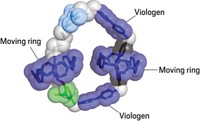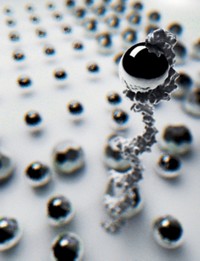Advertisement
Grab your lab coat. Let's get started
Welcome!
Welcome!
Create an account below to get 6 C&EN articles per month, receive newsletters and more - all free.
It seems this is your first time logging in online. Please enter the following information to continue.
As an ACS member you automatically get access to this site. All we need is few more details to create your reading experience.
Not you? Sign in with a different account.
Not you? Sign in with a different account.
ERROR 1
ERROR 1
ERROR 2
ERROR 2
ERROR 2
ERROR 2
ERROR 2
Password and Confirm password must match.
If you have an ACS member number, please enter it here so we can link this account to your membership. (optional)
ERROR 2
ACS values your privacy. By submitting your information, you are gaining access to C&EN and subscribing to our weekly newsletter. We use the information you provide to make your reading experience better, and we will never sell your data to third party members.
Materials
Rise Of The DNA Robots
Nanotechnology: Molecular machines stroll autonomously, transport cargo
by Bethany Halford
May 12, 2010
| A version of this story appeared in
Volume 88, Issue 20

Futuristic visions of nanobots that travel the body to treat disease and construct compounds one atom at a time got a little closer to reality this week, thanks to two advances in nanoscale robotics (Nature 2010, 465, 202 and 206). Using DNA as the key construction material, one group of researchers created a nanoscale robot that can autonomously walk across a track, and a different group prepared a nanofactory in which DNA robots can carry and deposit nanoparticle cargo.
The primary obstacle in making nanoscale robots is that their small size restricts the amount of information or programming they can carry. "How do we program molecules when they cannot hold much information?" asks Milan N. Stojanovic, a molecular computing expert at Columbia University. "In this paper, we do it by defining their interactions with the environment."
Stojanovic, along with groups led by Nils G. Walter of the University of Michigan, Erik Winfree of California Institute of Technology, and Hao Yan of Arizona State University, created that environment—a surface of DNA—using DNA origami, a technique in which small strands of DNA "staple" one long strand into a desired shape.
To that environment they added their nanorobotic walker, which has an inert body of streptavidin protein and four single-stranded DNA legs. The legs are designed to associate with pendant strands of DNA on the DNA origami surface. While one leg anchors the crawler onto the surface, the other three are so-called DNAzymes, which cleave the pendant strands once they've formed a duplex with it. Interaction with the shorter, cleaved strand is weak, so a leg travels along to the next dangling bit of DNA, propelling the walker along autonomously until it reaches strands that can't be cleaved.
The DNA-based walker in the second report, from New York University chemistry professor Nadrian C. Seeman's lab, has three hands and four legs all made up of single-stranded DNA. Anchoring strands of DNA help bind the legs to strands of DNA on an origami surface. The walker is freed to move by the addition of "fuel" strands of DNA that displace the anchoring strands, propelling the walker along. Adding more anchoring strands halts the motion. The walker's hands can take and carry gold nanoparticle cargo, which is held by DNA machines on the track, and can assemble the particles in a predefined manner. The entire system functions as a nanoscale assembly line, Seeman tells C&EN.
"This is the first time that systems of nanomachines, rather than individual devices, have been used to perform operations, constituting a crucial advance in the evolution of DNA nanotechnology," University of Wisconsin, Madison, chemistry professor Lloyd M. Smith writes in a commentary that accompanies the papers.
"A goal of our field is to refashion and reimagine all the complex biochemical machinery of cells to suit our own purposes—to have synthetic molecules that can move around and carry cargo as protein motors do in cells, to have molecules that act as chemical factories, which make a particular product based on a particular chemical input, and above all to make these processes modular, to make them engineerable," notes Paul W. K. Rothemund, the Caltech scientist who invented DNA origami. "These two papers mark a significant advance along this research direction."





Join the conversation
Contact the reporter
Submit a Letter to the Editor for publication
Engage with us on Twitter